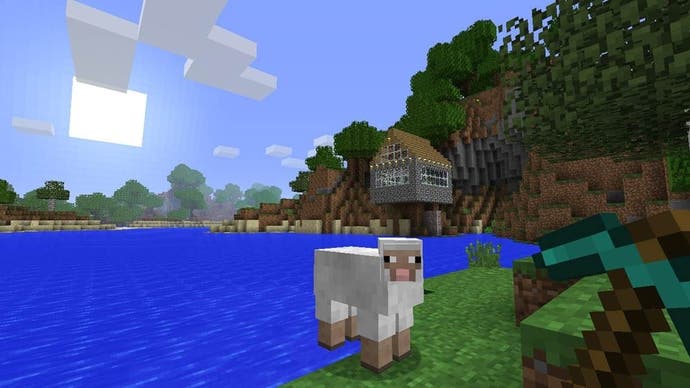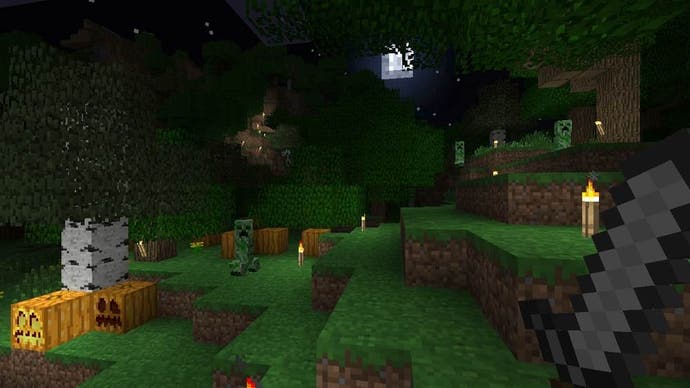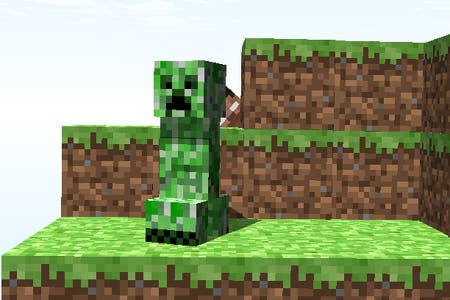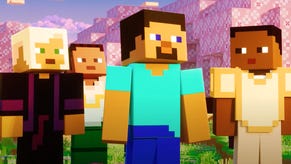Minecraft: Xbox 360 Edition Review
Digable planet.
I can't say that Minecraft passed me by - how could it? It's a full-blown 21st century sensation, a hit indie game that changed all the rules, a perfect storm of internet fame. It's been pretty hard to ignore.
But Minecraft did happen without me. Somehow I never played it - perhaps because I was foolishly waiting for it to come out of its endless alpha test - and all of a sudden it was a thing that I wasn't part of and didn't get, even though I understood it. Like so many of the great online PC games, from Counter-Strike to League of Legends, it became a cult that I didn't know how to join.
Well happy day, because this excellent new version for Xbox Live Arcade is made just for me. Mojang, the company formed by Minecraft's affable creator Markus "Notch" Persson, has worked with Microsoft and port specialist 4J Studios to build a Minecraft that's slightly less advanced, much easier to get to grips with and perfectly tuned for its slick and friendly platform, while preserving almost all of the original game's unquestioned genius.

It will never eclipse the one true Minecraft - for some pretty simple reasons, this is a phenomenon that could only ever have happened on computers - but Xbox 360 Edition is as close to an untamed sandbox as you can get in one shiny, sugared pellet of console gaming. It's the real deal. Accept no substitutes.
"It will never eclipse the one true Minecraft, but Xbox 360 Edition is as close to an untamed sandbox as you can get in one shiny, sugared pellet of console gaming."
In Minecraft, you mine and you craft. That's about it, especially in this earlier and simpler version of the game that doesn't feature the grind-heavy combat advancement and levelling which made it into the "final" "release" version of the PC game (the one we reviewed last year). It's no great loss; this is arguably a purer version of the game, and certainly a great point at which to start playing.
The goal of the game is both simple and ineffable: survive, prosper and build in a randomly generated block-world. You start with nothing, absolutely nothing, gathering wood with your bare hands to make tools to gather more materials to make more and better tools and materials.
You dig and you build. Use the right trigger to gather (or attack) with whatever you have equipped, hammering away with a comically speedy and repetitive motion, consuming the world around you as voraciously as Pac-Man. Use the left trigger to place items from your inventory in the world and build - the only limit to your imagination being your capacity to produce materials and ability to physically navigate to where you want to place them.

The space between these two interactions is filled with a crafting system - the habitual sideshow attraction of role-playing games, here placed firmly centre stage. By making a crafting bench and a furnace you can refine materials and make armour, weapons, tools, food, devices and equipment as well as structures and building materials. You can make doors, beds, torches, powered rails, boats, clocks, mushroom stew; sandstone, glass, brick, obsidian and diamond.
The Lego-like appeal of putting all this together to build your own world is clear and powerful, but Minecraft's brilliance goes deeper than that. There are two reasons that this game has been far more successful than so many before it, the Spores and LittleBigPlanets of this world, at encouraging players to create stuff. One is the extreme simplicity of the interface, even though the underlying simulation systems are complex. The other is the game of survival that provides the context and motivation for your efforts.
At night, monsters come out and attack you relentlessly, and you can't see because it's dark. Very dark. If you die, you respawn, but you've dropped everything you were holding - and where was that, anyway? Shelter and light are imperative, and at the beginning you build - or dig out and reinforce a cave - not because you want to but because you have to.
The potency of those first few days in Minecraft cannot be overstated. It's a frightening, hardscrabble existence. My first night, I just about managed to wall up a cave but hadn't got as far as making a bed or any torches, so there was nothing for it but to stare miserably at a black screen, listening to monsters groan and skitter, and wait for daylight to peer in through the one hole I'd left.

It's this primal threat that sets Minecraft's engine running. It's why you need to build a home, and make better armour and weapons for yourself, and prepare food to recover your health, and construct defences so you don't find an explosive Creeper at your door in the morning. You really do feel like a settler in a strange land. If this inspired game design has a flaw, it's that the survivalist tension is at its strongest at the start and gradually ebbs away into a rather aimless, listless mid-game where you have to hunt for resources before your grand design can really take hold.
All the same, it's a good deal less aimless in this new 360 version, which makes a few notable concessions to accessibility for this notoriously inscrutable game. There's a good tutorial that introduces you to the basics and lays out the essential strategies for survival, after which you can explore a premade fantasy village showing some of the amazing contraptions, structures and materials you can dream about founding in your own wilderness. There are also tooltips which pop up in-game with information about creatures and materials, so you won't need to scurry off to a wiki every five minutes.
More controversially, crafting has been radically simplified. You no longer need to place materials in shapes on a grid, discovering recipes through research or guesswork. You simply pick from a list and make what you want instantly. It's very handy and eliminates what would have been a cumbersome interface for the Xbox controller, but an important aspect of the game has undeniably been streamlined away here.
Finally, you start with a map in your inventory, a huge boon that allows you to chart the world as you roam and retrace your steps to where you died, or found that iron deposit, or left your house. (Well, it is a boon if you don't drop it where you die on the first night and never find it again.) Purists might find this version a little dumbed down, but in truth Minecraft's wild-frontier days are in the past now, so exhaustively has this game been explored and explained by its community, and what it gains in self-illuminating accessibility for newcomers is well worth it.
In all other respects, this is a supremely tight version of a classic game that gracefully navigates the limitations of its platform. The pad controls are taut, fast and logical. The Xbox 360's small memory and the lack of dedicated online servers means the worlds created in this Minecraft are smaller, and can never live online independently of their creators. On the other hand, it has never been simpler to share your Minecraft creation with a few friends; there's support for split-screen local multiplayer (a potential killer app for some fans), and simple toggles dictate whether your game will be online and open or invite-only.
What you can't do, though, is take videos and post them online (although it is possible to share screenshots via Facebook). This simple facility isn't even part of the original Minecraft's game code, it's just a side-effect of its choice of platform - and yet it is the single biggest reason for the runaway success of this quintessential community game. Without it, the Xbox 360 Edition feels like it's missing a limb. It exists in a bubble, every bit as compelling and fun as its parent, but nothing like as democratic or inspiring.
It doesn't have to be, though. Minecraft already exists in that form and has millions of evangelists; the phenomenon happened, it doesn't need to happen again. All this version means is that you no longer have an excuse for not joining in.









